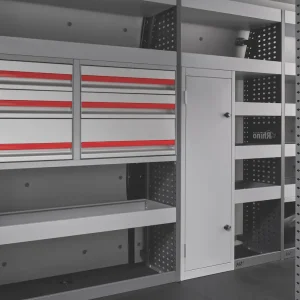
In recent years, it’s been impossible to miss the rise of AI, as a topic that’s broken out of the tech industry to make wider news headlines. Telematics providers would argue that, rather than representing a sci-fi future, AI is offering useful real-world benefits to fleet managers today.
Among the telematics companies with an AI interest is Geotab. It has been applying the technology to its products for a while, and last month added to this with the launch of Driver Risk Insights. This is a feature which, according to Geotab, shifts the focus from vehicle-based data to driver-specific analysis. It can provide a percentage-based collision risk probability for each driver on a fleet, based on driving behaviours and historical trends, as well as benchmark drivers’ performance against their colleagues, or against drivers on other fleets via Geotab’s anonymised aggregate data. It also delivers proactive coaching via the Geotab Drive App.
Geotab vice president of product management Sabina Martin says: “Fleets can’t afford to rely only on reactive safety measures. With AI-powered Driver Risk Insights, we’re giving fleet managers and drivers a predictive edge – helping them prevent collisions before they happen, reduce costs, and create a culture of continuous safety improvement.”
The Driver Risk Insights feature was unveiled at Geotab’s Connect 2025 event, where it also introduced Work Order Management, designed to allow fleet managers to streamline maintenance tasks through a centralised hub in the MyGeotab platform, consolidating scheduling, tracking, and reporting in one place.
In practice
The potential advantages of AI are demonstrated by a UK fleet which is using Geotab’s GO9 telematics devices in combination with Lytx Surfsight AI-12 dash cameras. This solution has been deployed by healthcare transport provider HATS Group’s 880-vehicle fleet, via Geotab’s official reseller LEVL, and is said to have led to a 78% reduction in road traffic incidents, with a 96% reduction in related costs, thanks to its real-time driver monitoring and coaching capability. In-cab alerts help drivers correct unsafe behaviours, while gathered data helps with targeted training programmes.
HATS Group head of all insurance Jon Trotter says: “With Geotab, I can now get a clearer picture of any incident which takes place with one of our vehicles and manage the associated risks better than I could have done before.
“The cameras, and the ease of access to that footage on the MyGeotab platform, makes managing fleet risk so much easier.”
Geotab associate vice president for EMEA, Aaron Jarvis, says: “Thanks to AI-powered video and telematics, HATS Group has significantly reduced incidents, improved driver behaviour, and lowered operational risks.
“These improvements not only enhance overall fleet safety but can also lead to a substantial reduction in insurance renewal costs. This success highlights the power of data-driven fleet management in delivering measurable, real-world impact.”
Fleet expectations
Lytx has also looked at AI as part of recent research carried out in partnership with fleet management provider Webfleet. A survey of UK fleet decision-makers found that 30% saw AI-driven predictive maintenance as key to enhancing safety and reducing mechanical failures over the next decade.
The research also found that 80% of van fleets were currently using video telematics incorporating AI for “critical safety challenges”, including for accident recording and evidence gathering. 31% of fleets said distracted driving was a leading cause of accidents, said to highlight the need for monitoring and feedback systems, while 52% said they were updating driver training programmes annually based on safety data insights.
The research also looked at other areas of fleet management, including driver mental wellbeing. It found that this was a priority, with 82% of fleets reporting formal processes to support drivers after incidents, and 88% of fleets reporting improvements in driver recruitment and retention after adopting tools to help protect their mobile workforce.
Lytx sales director Klaus Burgstaller says: “Intelligent video that can identify risky behaviour and alert drivers in real time is playing a vital role in helping to protect those behind the wheel.
“Empowering drivers with these tools means they can minimise the chance of an incident and also feel secure that evidence exists in cases where they were not at fault.
“Fleets that embrace these technologies demonstrate a commitment to driver wellbeing and a desire to ensure that every journey ends with a safe return.”
Webfleet UKI regional director for Bridgestone Mobility Solutions Beverley Wise says: “Driver mental wellbeing is a critical component of effective safety strategies. Addressing the emotional toll of incidents is just as important as leveraging technology to improve safety.
“By investing in both driver support and innovative safety solutions, fleets can create safer roads and build a more resilient workforce.”
Asset tracking
Teletrac Navman is another name which is well-established in the field of AI-based telematics, with its TN360 platform. This is now compatible with asset trackers, newly launched by the company, with one-time install and indoor tracking capabilities, allowing managers to view asset location, maintenance and utilisation.
In addition, the company has published results from its AI and Driver Safety survey – a new supplement to its 2025 Distracted Driving & Driver Safety Report – showing that 83% of surveyed fleets said that AI was the future of safety.
The research also found that 26% of fleets were testing or piloting AI safety solutions and 18% were exploring options, with 32% of respondents saying that AI would be used to monitor driver behaviour in real-time.
Teletrac Navman CEO Alain Samaha says: “The use of AI by fleets is expanding from, primarily, fleet planning to fleet operations. There are clear safety advantages in harnessing AI with vehicle and dashcam data including preventing accidents by reducing distracted driving.”
Teletrac Navman’s research also revealed some concerns about AI, with 23% of respondents said they were concerned about data privacy, and 14% fearing resistance from drivers or staff.
Samaha adds: “Camera and telematic data, in combination with AI, have the potential to be a very powerful tool for fleets who need to cut their exposure to risk. However, people are integral to making that happen, especially in situations where there may be concerns from drivers and unions. Effective communication is key.” λ





